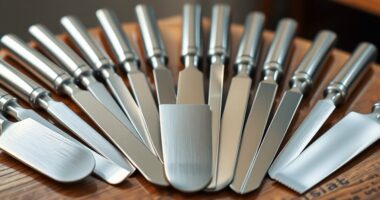Looking for the best laminated color mixing guides for artists and crafters? I recommend options like the Magic Palette Studio Guide, which features 841 colors, and Cox’s pocket-sized 3×5 guide, perfect for portability. Outus’s color wheel sets and JimKing’s creative guides are also great for quick reference. These guides are durable, easy to clean, and perfect for mastering color blends on the go. Keep exploring to find the perfect tool to boost your color skills.
Key Takeaways
- Look for guides with high-quality, durable lamination that resist wear, moisture, and fading for long-lasting use.
- Choose sizes that balance portability with sufficient space for detailed color mixing and reference.
- Ensure the guide includes comprehensive recipes, color swatches, and mixing formulas for oil, acrylic, and watercolor paints.
- Opt for guides with clear labels, organized layouts, and vibrant printing for quick, accurate color matching.
- Consider user reviews and ratings to find highly-rated laminated guides preferred by artists and crafters.
Color Mixing Recipes for Artists: Oil, Acrylic & Watercolor Techniques
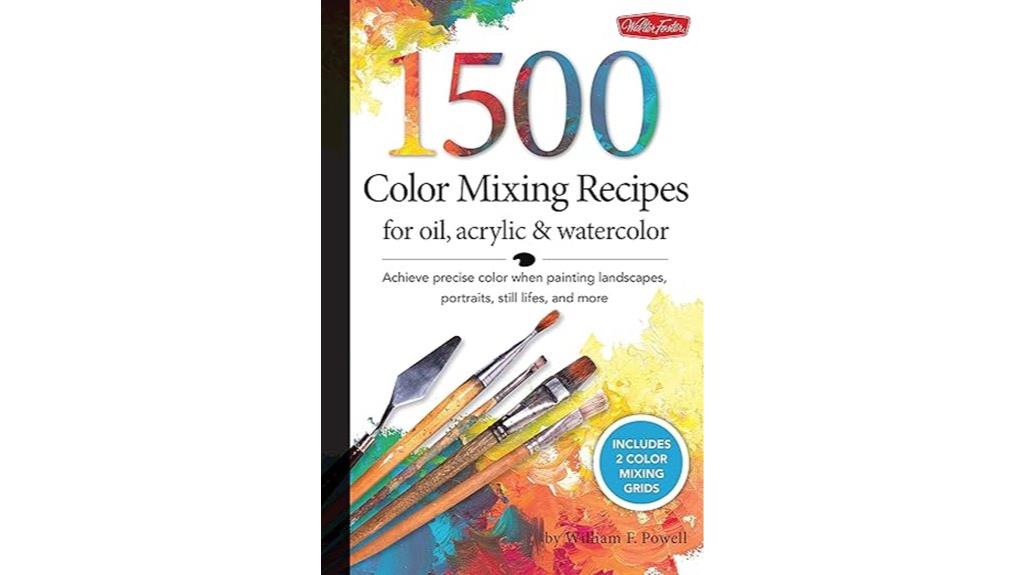
If you’re an artist looking to master color mixing across different mediums, the “Color Mixing Guides Laminated” is an invaluable resource. It offers 1,500 recipes covering oil, acrylic, and watercolor paints, consolidating previous editions into one all-encompassing guide. The book provides detailed color swatches, mixing formulas, and insights into natural hues like skin tones, landscapes, and facial features. Its logical organization by subject helps you quickly find the right recipes for your project. Durable pages, visual aids, and a layout designed for easy use make it ideal for artists of all skill levels, helping you reduce guesswork and develop a deeper understanding of color relationships.
Best For: artists of all skill levels seeking a comprehensive, durable, and easy-to-use guide for mastering color mixing across oil, acrylic, and watercolor mediums.
Pros:
- Extensive collection of 1,500 detailed color recipes and swatches for various subjects and natural hues
- Durable, wipe-clean pages with a layout that opens flat, facilitating easy reference during painting sessions
- Organizes recipes logically by subject, making it quick and convenient to find the right color mixes for specific projects
Cons:
- Spiral binding can be limiting on larger volumes, though the book remains functional once the cover is lost
- Slightly heavy and bulky, which may be less portable for on-the-go use
- Some users with visual challenges may find the detailed recipes overwhelming without prior color theory knowledge
Magic Palette Color Mixing Guide 11.5 Inch
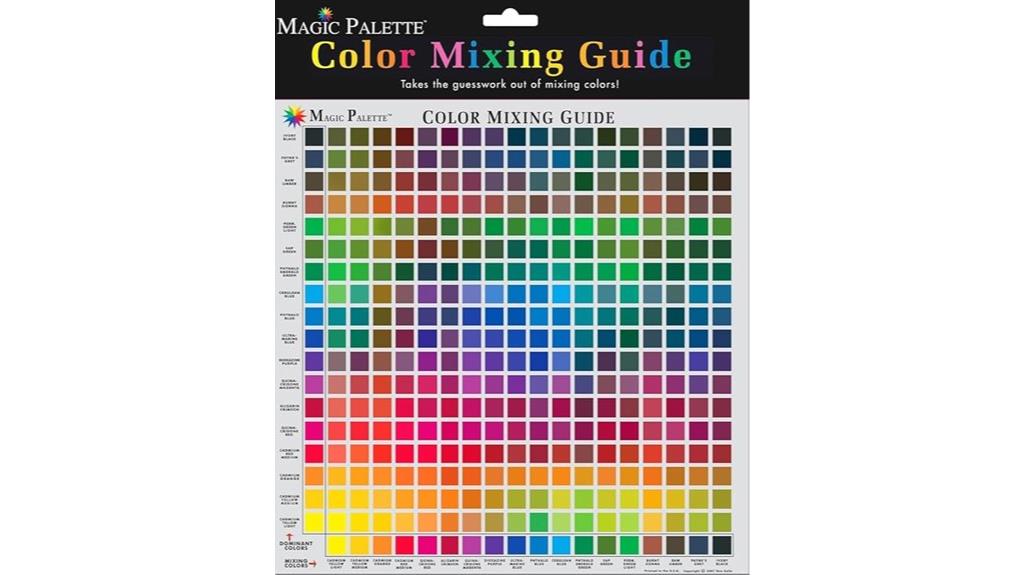
The Magic Palette Color Mixing Guide 11.5 Inch is perfect for artists who want a reliable, large surface to experiment with color blends. Its spacious 11.5-inch palette provides ample room to mix and test various colors accurately. Crafted by the Color Wheel brand, it features a modern style with dimensions of 14.5L x 12W inches, making it easy to handle. Weighing just 0.8 ounces, it’s lightweight and portable. With over a thousand reviews and a 4.5-star rating, it’s a popular choice among artists seeking a durable, easy-to-use mixing palette. This guide helps improve color accuracy and blending skills for all levels.
Best For: artists and hobbyists seeking a large, reliable surface for precise color mixing and blending experiments.
Pros:
- Spacious 11.5-inch palette surface allows for extensive color testing and blending.
- Lightweight and portable at only 0.8 ounces, easy to carry and handle.
- Highly rated with 4.5 stars from over a thousand reviews, indicating durability and user satisfaction.
Cons:
- Not dishwasher safe, requiring careful hand cleaning.
- No batteries or electronic features, limiting functionalities.
- Surface may be susceptible to damage if handled improperly or exposed to extreme temperatures.
Color Mixing Guide – Magic Palette Studio Color Guide – 841 Colors
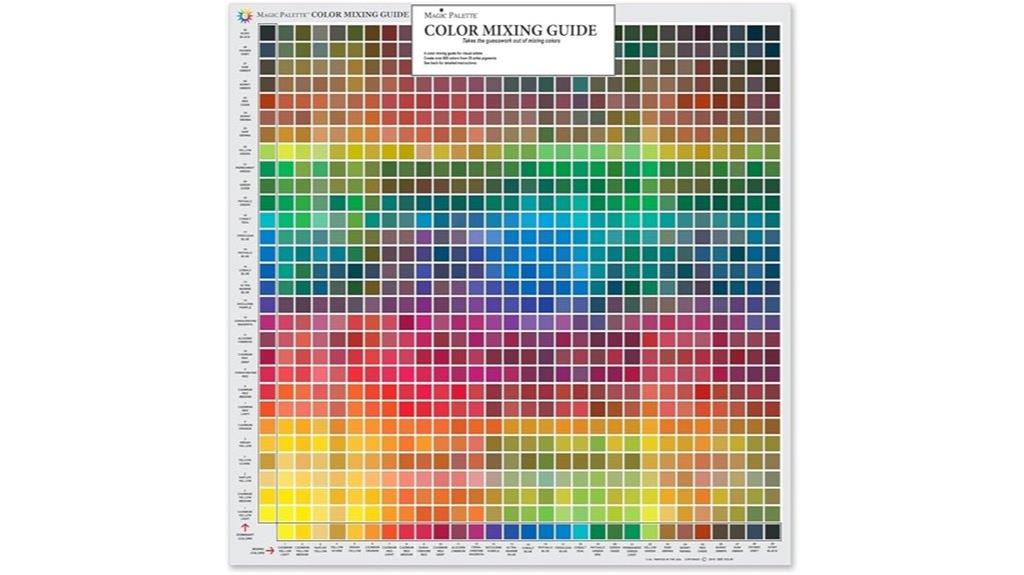
Designed for artists, students, and educators alike, the Color Mixing Guide – Magic Palette Studio offers 841 carefully curated color mixes derived from just 29 primary paint colors. This detailed guide simplifies color creation by providing precise combinations, making it easier to achieve the perfect hue every time. Printed on high-quality material, it guarantees accurate color representation and durability. Measuring 24 x 24 inches, it’s versatile for studio, classroom, or creative workspace use. Whether you’re learning color theory or working on professional projects, this guide helps you explore a broad spectrum of colors efficiently, boosting confidence and inspiring creativity.
Best For: artists, students, and educators seeking a comprehensive, accurate color mixing reference to enhance creativity and learning in their art projects.
Pros:
- Provides 841 carefully curated color mixes from only 29 primary colors, saving time and effort.
- Printed on high-quality, durable material ensuring accurate color representation and longevity.
- Versatile size (24 x 24 inches) suitable for studio, classroom, or workspace environments.
Cons:
- Moderate customer rating of 3.7 out of 5 stars may indicate varying user satisfaction.
- Ranks relatively low in popularity (#215,768 in Arts, Crafts & Sewing), suggesting limited market penetration.
- Price and availability can vary, and some users might find it more expensive compared to digital or smaller reference tools.
JimKing Creative Color Wheel for Art and Makeup
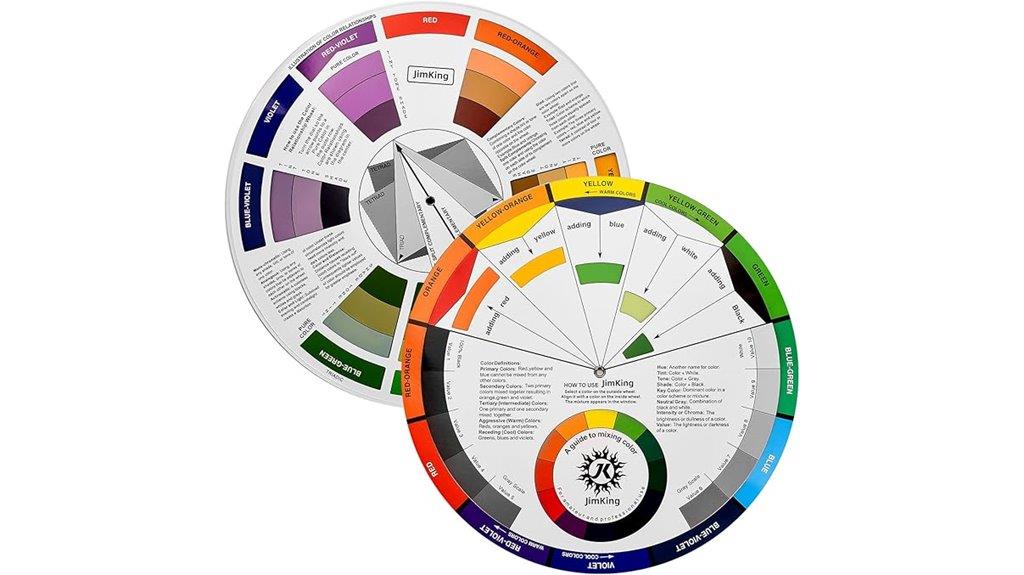
The JimKing Creative Color Wheel for Art and Makeup is an ideal choice for artists looking to improve their understanding of color mixing and organization. Its two-sided rotating design, with a 230mm diameter, makes it portable and easy to use. The UV coating protects against fading and moisture, while the durable paper cover guarantees safe transport. Suitable for painters, makeup artists, tattooists, and crafters, it helps users identify, organize, and understand color interactions effectively. This tool is perfect for beginners and professionals alike, supporting better color choices and blending skills. Plus, its stability and durability make it a reliable addition to any creative toolkit.
Best For: artists, makeup professionals, tattooists, and crafters seeking to enhance their understanding of color mixing, organization, and interaction.
Pros:
- Portable and easy to use with a 230mm rotating wheel design
- UV coating offers protection against fading and moisture damage
- Durable hardboard base and protective paper cover ensure long-lasting use and safe transport
Cons:
- May require some initial learning for beginners to fully understand color interactions
- Limited to color organization and mixing, not suitable for detailed painting or makeup application
- Size might be less convenient for very small workspace setups
Cox Pocket Guide to Mixing Color, 3X5
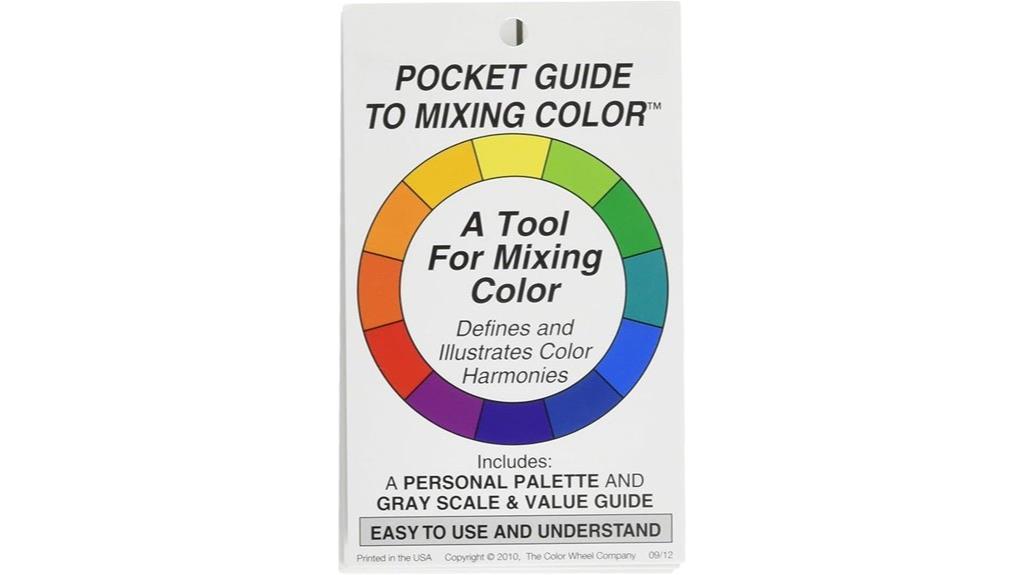
Are you looking for a portable, easy-to-understand color reference for quick mixing and harmony ideas? The Cox Pocket Guide to Mixing Color, 3X5 is perfect for artists on the go. Its compact, laminated design folds into a 3 x 5-inch case, making it easy to carry anywhere. The guide offers detailed info on color families, harmonies, tints, shades, and tones, with helpful illustrations and definitions. While some users note minor inaccuracies, especially in the split complementary charts, most find it clear and practical. It’s especially useful for beginners or anyone needing a quick, reliable reference during projects, plein air painting, or makeup application.
Best For: artists, students, and makeup professionals seeking a compact, easy-to-understand color reference for quick mixing ideas and harmony guidance.
Pros:
- Highly portable and lightweight, ideal for on-the-go use
- Clear visuals and definitions that simplify color theory for beginners
- Provides practical harmony diagrams and mixing tips in a compact format
Cons:
- Some inaccuracies reported in split complementary color charts
- May be considered expensive for a simple laminated guide by some users
- Less useful for experienced artists familiar with advanced color concepts
Pantone Formula Guide for Color Matching
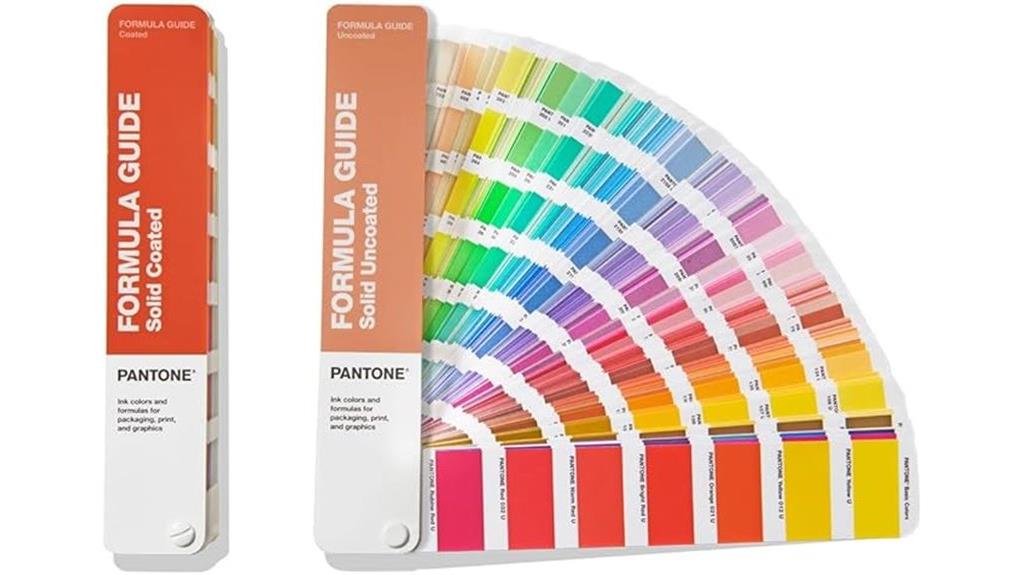
If you need a reliable tool for precise color matching, the Pantone Formula Guide is an essential choice. This compact, handheld guide features two fan decks—coated and uncoated—that provide accurate color references for branding, printing, and design projects. It includes printed color pages on standard paper stocks, along with ink formulations and corresponding numbers for easy identification. Designed for indoor use, it’s perfect for press checks, color communication, and ensuring consistency across materials. Weighing just over 2.5 pounds, it’s portable and straightforward to use, making it a must-have for professionals seeking dependable color accuracy.
Best For: graphic designers, branding professionals, and print specialists seeking precise and consistent color matching tools for their projects.
Pros:
- Compact, portable design ideal for on-the-go use and press checks
- Includes both coated and uncoated fan decks for versatile color matching
- Provides clear ink formulations and color identification for accurate reproduction
Cons:
- Not waterproof or water-resistant, limiting outdoor or damp environment use
- Designed primarily for indoor use on paper surfaces, restricting application scope
- Heavier than some digital color tools, which may affect portability for some users
Creative Mark Double-Sided Color Wheel Mixing Guide
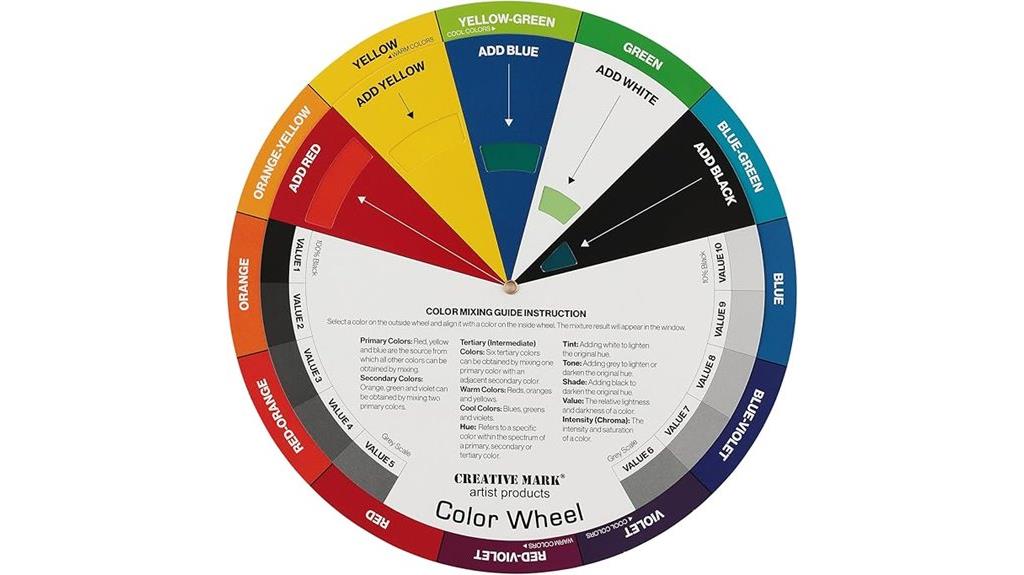
For artists, students, and teachers seeking an easy-to-understand, portable color mixing reference, the Creative Mark Double-Sided Color Wheel Mixing Guide stands out as an ideal choice. Measuring 9.25 inches, it features 60 colors based on the Munsell system, with a dual-sided design that shows color relationships, mixing tips, and grayscale options. It visualizes tints, tones, and shades, making it perfect for learning color harmony across various fields like painting, design, and crafts. Its pocket size adds convenience for on-the-go use, and customer feedback highlights its ease of use and versatility, making it a valuable tool for both beginners and professionals.
Best For: artists, students, teachers, and creative professionals seeking a portable, comprehensive color mixing guide to enhance their understanding of color harmony and relationships.
Pros:
- Easy-to-understand double-sided design with clear visualizations of color relationships and mixing tips
- Portable pocket size makes it convenient for on-the-go use and fieldwork
- Suitable for a wide range of fields including art, design, crafts, fashion, and auto painting
Cons:
- Some users find the material slightly flimsy or fragile over time
- Initial learning curve for beginners unfamiliar with the Munsell system or color theory
- Limited to 60 colors, which may not cover all specific color needs for advanced projects
Outus 2 Pcs Color Wheel for Painting and Makeup
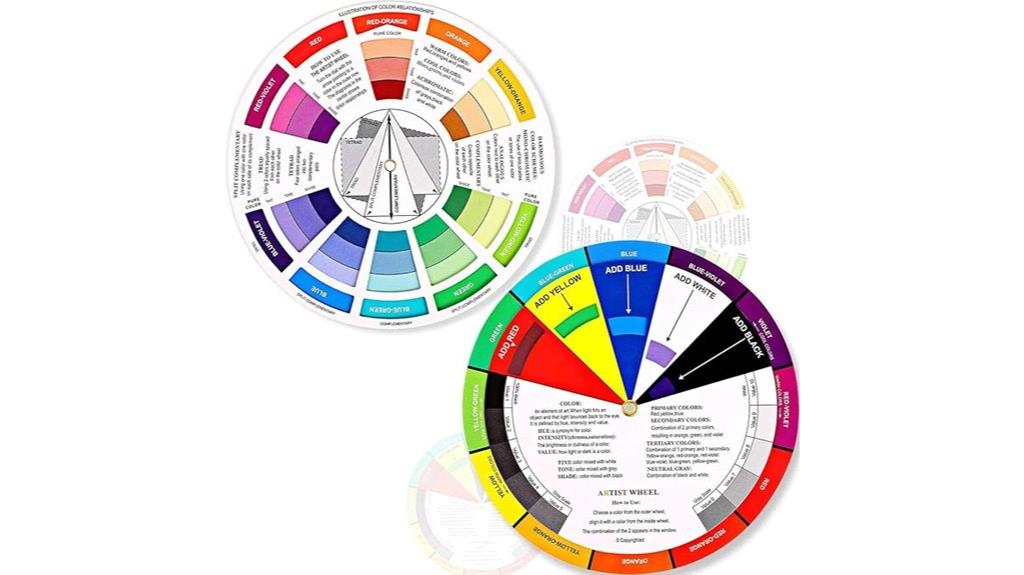
The Outus 2 Pcs Color Wheel is an excellent choice for artists, teachers, and students who want to master color theory effortlessly. With a 5.5-inch diameter, these wheels are perfect for hands-on learning about color relationships, mixing, and compatibility. Each set includes two wheels with different front and back designs, making it easy to explore basic color principles, complementary colors, tints, tones, and grayscale. Made of durable cardboard with smooth rotation, they’re ideal for painting, makeup, crafts, and interior design. The visual guides and interactive features make understanding color relationships intuitive, fun, and practical for various creative projects.
Best For: artists, teachers, students, and creative enthusiasts looking to improve their understanding of color theory and enhance their artistic projects.
Pros:
- Durable cardboard construction with smooth rotation for easy use
- Includes two different designs for comprehensive learning on color relationships
- Suitable for various applications such as painting, makeup, crafts, and interior design
Cons:
- Not waterproof; may be damaged by water-based paints or liquids
- Limited to 5.5-inch size, which may be small for some detailed projects
- Made of cardboard, which may be less durable compared to plastic or metal alternatives
Color Mixing Guide Mini – Magic Palette Studio Color Guide
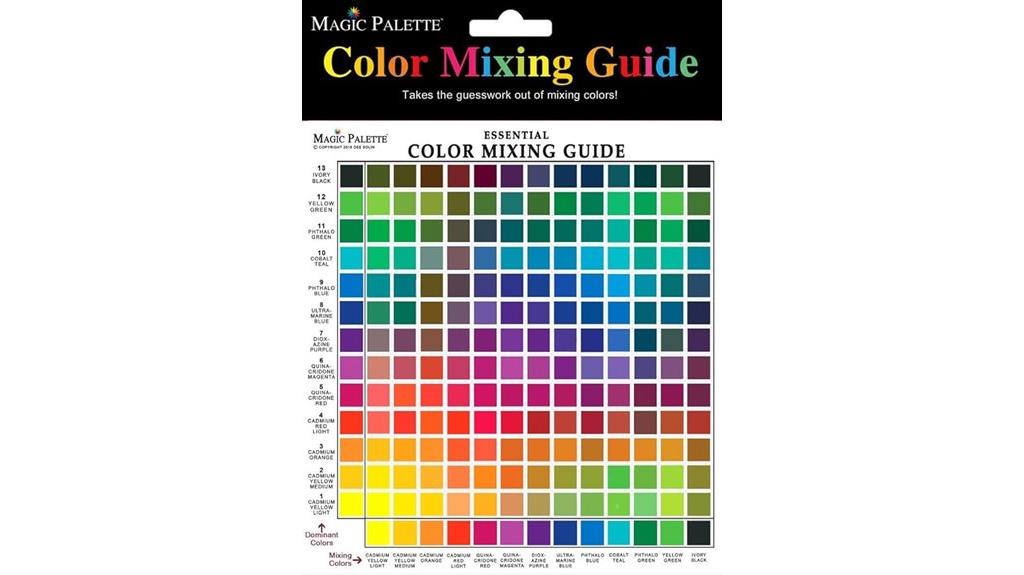
Designed as an essential learning tool, the Color Mixing Guide Mini – Magic Palette Studio Color Guide is perfect for artists and students enthusiasticto master color blending. It features 150 colors within a compact 6.5 x 7-inch size, including 12 key hues from the classic color wheel plus black and white. The guide provides step-by-step instructions for mixing and creating new shades, encouraging experimentation. I appreciate how it uses real paints and historic pigments, making learning both practical and inspiring. Whether for practice or inspiration, this guide helps users understand color theory while developing their blending skills efficiently.
Best For: artists and students eager to master color blending through practical, step-by-step guidance using real paints and historic pigments.
Pros:
- Encourages experimentation and discovery with 150 colors and comprehensive instructions.
- Uses real artist-grade paints and historic pigments to enhance learning and inspiration.
- Compact size (6.5 x 7 inches) makes it portable and easy to use anywhere.
Cons:
- Limited to 150 colors, which may not cover every hue an advanced artist might need.
- Plastic construction might be less durable compared to other materials.
- Slightly higher price point for a color mixing guide could be a consideration for some buyers.
Color Mixing Guides and Color Wheel Sets
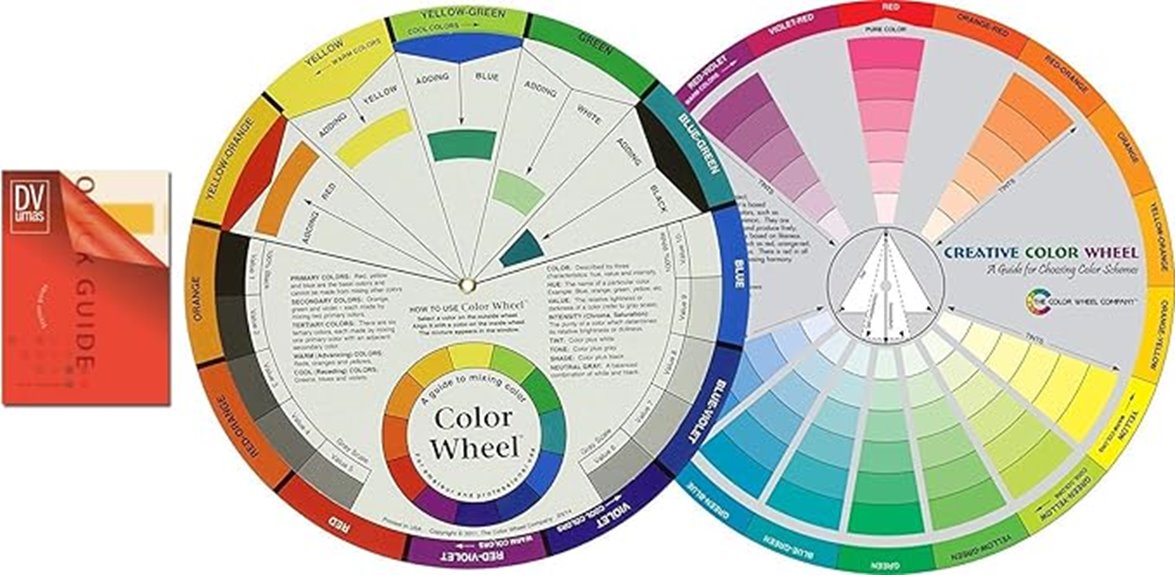
If you’re learning about color harmony or want quick, reliable references, the laminated Color Mixing Guides and Color Wheel Sets are perfect for you. These 9-1/4-inch wheels, made in the USA, visually demonstrate color relationships like complements, split complements, and triads, helping you master color schemes easily. The set includes a primary tool and a creative wheel, along with the Color Schemes Guide by Dumas V—ideal for beginners. They show how to tint, shade, and mix colors, making complex concepts simple. Compact and lightweight, they’re great for artists and crafters seeking a handy, durable resource to create cohesive palettes.
Best For: artists, designers, and crafters of all skill levels seeking a clear, portable, and reliable tool to learn and apply color harmony and mixing techniques.
Pros:
- Visual demonstrations of color relationships make complex concepts easy to understand
- Compact, lightweight design for portability and convenience
- Includes a helpful color schemes guide, ideal for beginners and quick referencing
Cons:
- Limited to 9-1/4 inch size, which may be small for detailed projects
- May require supplementary tools for advanced color mixing techniques
- Some users might prefer digital resources for more versatile or extensive color exploration
Factors to Consider When Choosing Color Mixing Guides Laminated
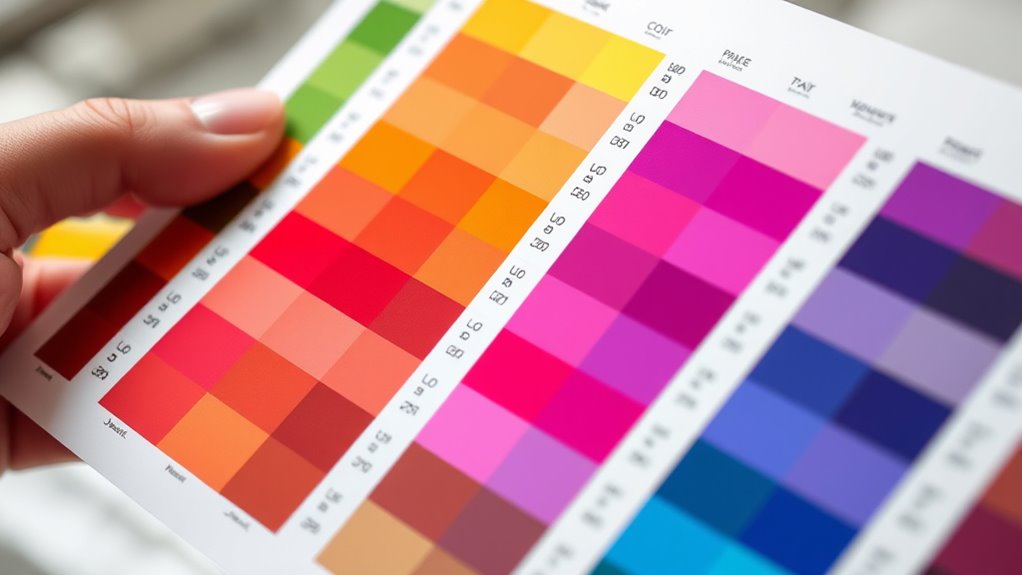
When selecting a laminated color mixing guide, I consider factors like durability, material quality, and how well it holds up over time. Size and portability matter, especially if I need to carry it around or work on the go. I also look for clear visuals, accurate colors, ease of use, and a price that offers good value for my needs.
Durability and Material Quality
Choosing a laminated color mixing guide requires careful attention to durability and material quality because these factors directly impact the guide’s longevity and usability. High-quality guides are made from sturdy plastic or coated paper, making them resistant to wear from frequent handling. The lamination itself plays a vital role, preventing water damage, smudging, and fading, so the guide stays clear and readable over time. Thicker laminates add rigidity, reducing warping and bending during use, which is essential when working on detailed color mixing. Good materials also make cleaning easy—simply wipe off stains without damaging the surface. Overall, durable materials ensure the guide withstands the demands of various environments, whether in a busy classroom, a studio, or outdoors.
Size and Portability
Selecting the right size for a laminated color mixing guide depends on how you plan to use it. If you need detailed information and more workspace, an 11.5-inch diameter guide provides ample surface area for complex color relationships and instructions. On the other hand, a small, pocket-sized guide around 3 x 5 inches is highly portable and perfect for quick reference during outdoor sessions or on-the-go projects. Lightweight guides, weighing just a few ounces, are easy to carry in a bag or pocket without adding bulk. Durability is also key; thicker laminated guides withstand frequent handling and travel, making them ideal for classroom or outdoor use. Consider your workspace and travel needs to find a size that balances visibility with portability.
Visual Clarity and Color Accuracy
A well-designed laminated color mixing guide not only offers portability and durability but also guarantees that the colors and information are easy to see and interpret. High-quality printing ensures vibrant, true-to-life colors that enable precise mixing. The laminated surface reduces glare and enhances contrast, making it easier to distinguish subtle color differences under various lighting conditions. Clear, legible labels and a well-organized layout help me quickly identify colors and understand their relationships, which is essential for accurate mixing. The durable lamination prevents smudging, tearing, or fading over time, maintaining consistent color fidelity. Accurate reproduction of color schemes, such as complementary or analogous colors, ensures I can rely on the guide for effective learning and application in my projects.
Ease of Use
When evaluating laminated color mixing guides, ease of use is essential for practical application. A well-designed guide should be straightforward to navigate, with clear, organized layouts that help me quickly find the color relationships and mixing ratios I need. Labels and visual aids like charts and diagrams make learning faster and reduce guesswork. Double-sided or foldable options are especially handy, offering multiple views or extra information without cluttering the space. The durability of laminated surfaces means I can wipe away mistakes and keep the guide in good condition, even after frequent use. Plus, their lightweight, portable design allows me to bring them to workshops or painting sessions without hassle. Overall, a user-friendly guide enhances my workflow and saves valuable time.
Price and Value
Considering the price of laminated color mixing guides is essential to guarantee you’re getting good value for your money. I look at how durable the guide is and how much educational content it offers—these factors influence its worth. Comparing prices across sellers helps me find options that balance affordability and quality, as some guides cost more but don’t necessarily provide extra benefits. Higher-priced guides often include comprehensive information, better materials, and features like detailed color theory or multiple schemes, which can justify the investment. I also consider my budget and how often I plan to use the guide—professional use or frequent practice makes durability crucial. Sometimes, spending a bit more upfront on a well-made guide saves money and enhances learning in the long run.
Content Comprehensiveness
Choosing a color mixing guide that offers thorough content makes a significant difference in how effectively I can learn and apply color theory. A good guide should include detailed recipes and formulas for a broad spectrum of hues across mediums like oil, acrylic, and watercolor paints. It needs to feature extensive visual swatches and examples, especially for natural variations in skin tones, landscapes, and complex subjects, to help me reproduce colors accurately. Clear explanations of color relationships, harmonies, and mixing principles are essential for understanding how colors interact. An organized, easy-to-navigate layout, with subject-specific recipes such as portraits or foliage, makes quick referencing possible. Durable, wipeable pages and logical design guarantee the guide remains useful and accessible over time, supporting ongoing learning.
Compatibility With Mediums
To get the most accurate results from a laminated color mixing guide, I need to make sure it’s compatible with my chosen medium, whether that’s oil, acrylic, or watercolor paints. This means checking if the guide includes pigment information specific to my medium to ensure precise color matching. I also verify that the surface material suits my medium’s application; for example, waterproof guides work well with watercolors and oil paints. Additionally, I look for calibrated color representations that account for my medium’s opacity and transparency to avoid misleading expectations. Finally, I consider whether the mixing instructions are tailored for my medium’s consistency and drying times, ensuring practical and effective use during my projects. Compatibility is key to achieving consistent, predictable color results.
Frequently Asked Questions
How Durable Are Laminated Color Mixing Guides for Daily Use?
Laminated color mixing guides are incredibly durable for daily use. I’ve found they hold up well against spills, smudges, and frequent handling. The lamination protects the paper from tearing and water damage, making them perfect for busy art studios or craft rooms. I can confidently use mine every day without worrying about wear and tear, and they still look new after months of use.
Can These Guides Be Customized for Specific Projects or Color Palettes?
These guides are like a blank canvas ready for your personal touch. You can customize them for specific projects or color palettes by using waterproof markers, or even printing custom sections to stick on. I often add my favorite shades and mixing tips to make them uniquely mine. It’s like tailoring a suit—perfectly fitted for my creative needs, making my art process smoother and more enjoyable.
Are Laminated Guides Suitable for Digital Artists or Only Traditional Mediums?
Laminated guides are mainly designed for traditional mediums, but I find they can be useful for digital artists too. I use them as quick reference tools alongside my digital workspace, especially for understanding color mixing principles or planning palettes. They’re portable, durable, and easy to glance at, helping me stay creative and organized, whether I’m working with paint or pixels.
How Do Laminated Guides Compare to Digital Color Mixing Tools?
Ever wonder if laminated guides are as handy as digital tools? I think they’re great for quick, tactile reference, especially when I don’t want to switch screens. While digital tools offer endless options and easy adjustments, laminated guides are portable and reliable without batteries or glitches. They complement each other—digital for versatility and laminated for convenience. It’s all about what works best for your specific art or craft needs!
What Maintenance Is Required to Keep Laminated Guides in Optimal Condition?
To keep laminated guides in top shape, I regularly wipe them with a soft, damp cloth to remove dust and smudges. I avoid harsh cleaners or abrasive materials that could damage the surface. When not in use, I store them flat or upright in a cool, dry place to prevent warping. This simple upkeep helps me preserve their clarity and usability for my art projects.
Conclusion
Whether you’re a seasoned artist or a passionate crafter, these laminated color mixing guides are your trusty compass in a sea of hues. They turn complex color theory into a simple, accessible map—your secret weapon for vibrant, harmonious creations. With these guides by your side, you’ll navigate the world of color with confidence, transforming every project into a masterpiece. After all, isn’t mastering color the key to revealing your true artistic potential?




